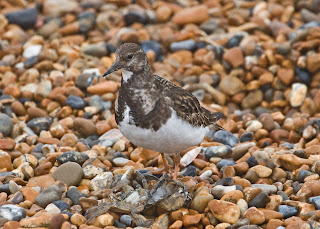The discerning of you will have noticed that there hasn’t been an update since before Christmas. Well the reality is I’ve not been out much. The kids have been home for Christmas and since they are only around for a few days disappearing for a days birding would not have gone down too well. We’ve also done a tour of the home counties delivering Christmas presents that we failed to get delivered due to the snow. This was made really unpleasant due to the number of people visiting Lakeside and Blue water for the post Christmas sales - the M25 was at a standstill.
I have managed to grab the odd hour out here and there so I though I’d bring this diary up to date.
It was dull and wet on the 23rd but I read about the scaup at Dover and since I needed to go to Dover
I started at DeBradley Warf car park but no sign then went on to the west end of the dock…..still no sign. I repeated the search and was about to leave when it put in an appearance by the bridge.. I only managed a few shot because the instant it saw me it paddled off as fast as it could and disappeared between the boats. I could just about see it but it spent a lot of time under the floating pontoons and amongst the moored boats.
I did try again on the 24th but whilst I was there it was even more distant and the pictures worse than the one above. I also had a wander out onto the Prince of Wales pier on the 24th but there was little to see – a single med gull on the hover pad and Stumpy the turnstone (or an impersonator) on the pier itself – it does respond to feeding so if you throw something down for it to eat it will come within a few feet of you.
Today (29th) I was going to go out for the morning but I awoke to fog and drizzle – bring back the snow if this is the alternative!
I did eventually go out but more for the exercise than in expectation of seeing much. I drove to Sandown Castle
Within a few yards of the “castle” (not a castle now little more than a mound) I found a 1st winter med gull and a party of 5 turnstones and inland there were a few thrushes – 3 mistle thrushes being the highlight.
Further on some large puddles have formed between the footpath and the golf course so I went looking for jack snipe. Not to be but I did find a female stonechat (more scarce than shore larks this year) and 3 meadow pipits.
A bit further on I saw 3 birds flying north. They were out to sea and in the fog and I didn’t spot them till they were well past – I know this sounds crazy but they really did look like bitterns.
Once I reached the Chequers I went inland to the Cinque Ports GC reservoir but nothing there this morning and there were no geese on Worth Marsh but as I was counting the lapwing(60) I saw a sparrow hawk being chased by a crow. At the Chequers barn there were 6 corn buntings plus the resident house sparrows and chaffinch.
I decided to retrace my steps and went back onto the beach where I immediately found 4 snow buntings – the highlight of the walk. The light was rubbish and they flew off south into the mist almost as soon as I’d found them.
By now the fog was clearing a little and out on the sea there was a largish flock of ducks (~100). fortunately they took to the air calling – wigeon. With the fog thinning I could also see 13 gt crested grebes.
The only other thing seen on the way back were the turnstones – now up to 6.
On the drive home I checked Walmer paddock (I always do now with cattle egret and bean goose turning up in the last year or two) and saw an egret. One emergency stop later and I was looking at a little egret but it got the pulse going for a moment. I did take some pictures but the mist had decended again and the pics were rubbish.

















































